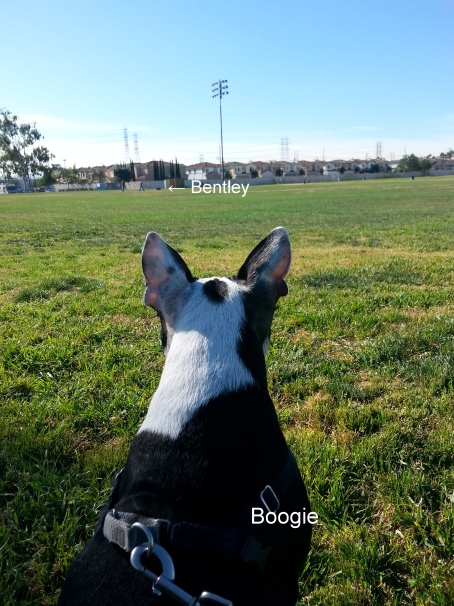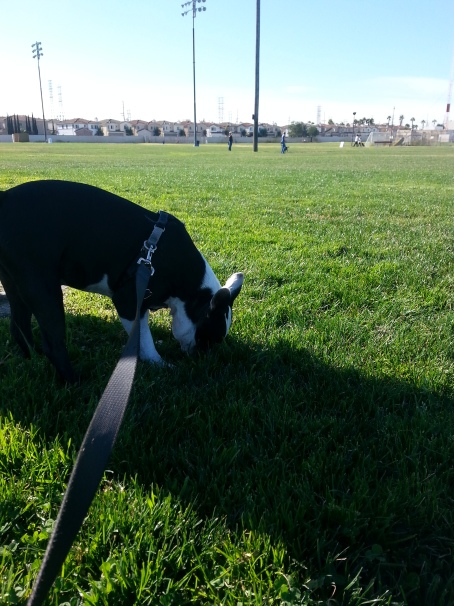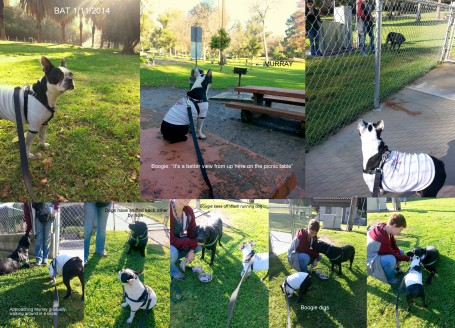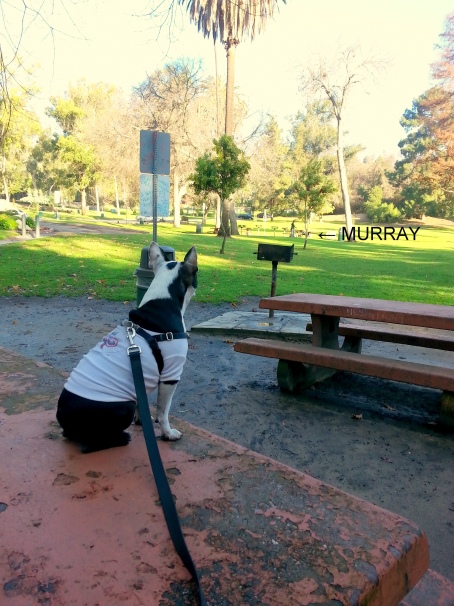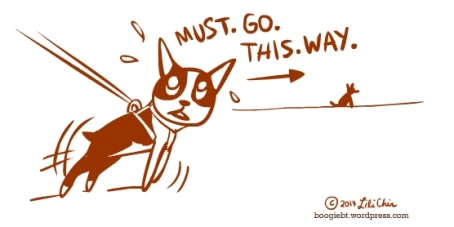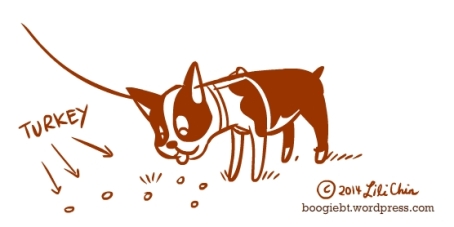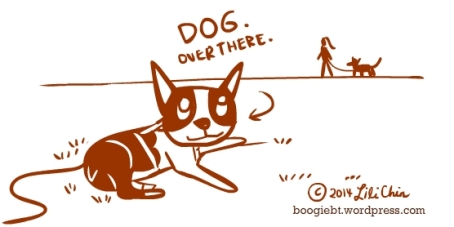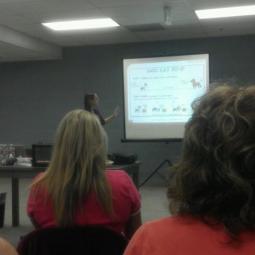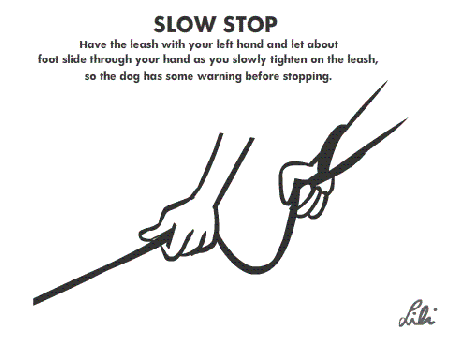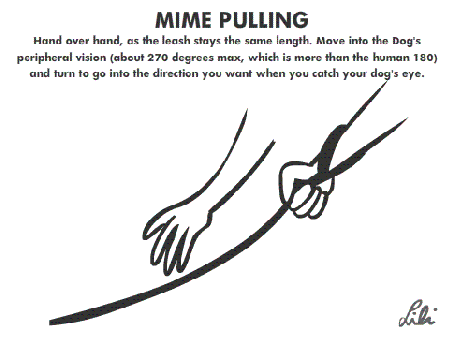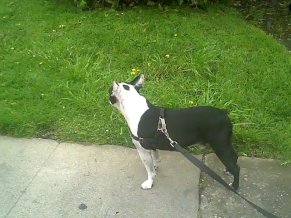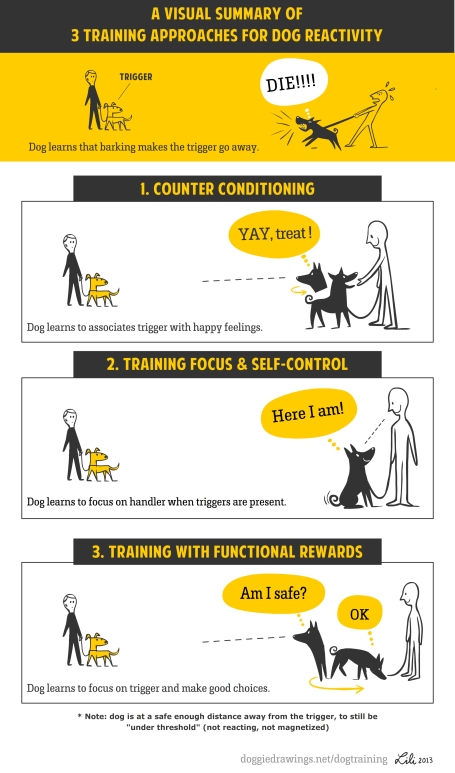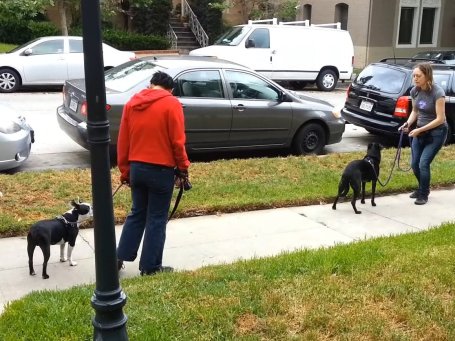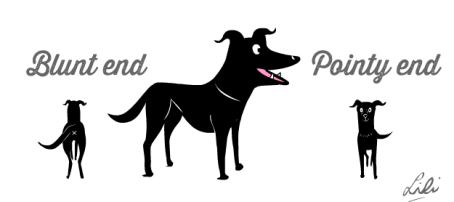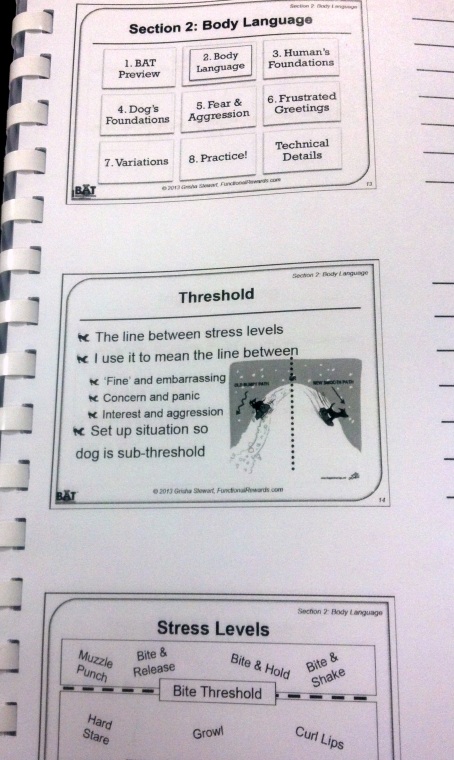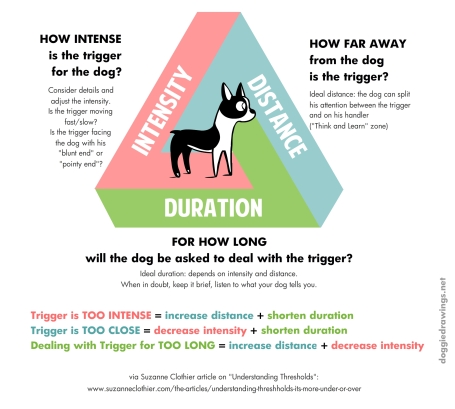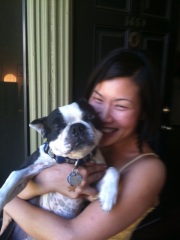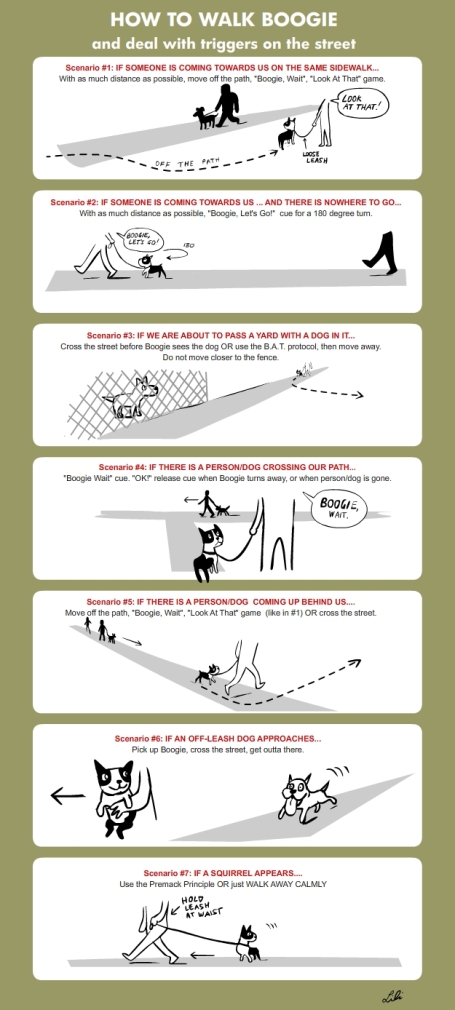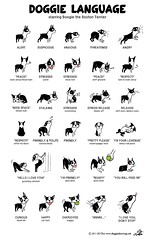Posts filed under ‘BAT sessions’
Two BAT set-ups – January 2014 (BEFORE BAT 2.0)
I want to share some photos and observations from the two BAT set-ups that Boogie and I did last month.
**Please note that when we did these set-ups I had not read all the new BAT 2.0 instructions. The new BAT handouts weren’t available yet.**
SET-UP #1
Location: A park in Torrance.
Student Dog 1: BOOGIE with me
Student Dog 2: BENTLEY with Kristin Burke
Naturally occurring reinforcers: Lots of grass, trash cans, a fence to sniff/pee on + information from the other dogs/people in the park.
Natural triggers/aversives: Really hot midday sun, one reactive dog in the distance, open field with flat horizon so any people/dogs in the distance were more obvious (Sudden environmental changes)
Food reinforcer: Ham
Bentley is Kristin Burke‘s cattledog. We started at the distance shown in the photo below, and ended with both dogs about 20-30 feet from each other, with a fence in between.
SET UP #2
Location: Elysian Park.
Student dog: BOOGIE with me and Megan McGrath
Helper dog: MURRAY with Chelsea
Naturally occurring reinforcers: Grass, trees, bushes, trashcans, picnic tables, squirrels, lots of smells, giant space + information from other people/dogs
Natural triggers/aversives: Joggers, loose dogs in the distance
Food reinforcer: Turkey
Murray is Megan McGrath‘s very mellow black lab. Chelsea handled Murray while Megan walked behind me to observe and offer guidance whenever I needed it. Boogie and I moved all around the park, sort of circling closer towards Murray, with breaks. We also did some parallel walking with a fence between the two dogs and eventually, the two dogs met.
These two occasions were cool because we had the luxury of large spaces to work in that were quite peaceful, and Boogie was able to move around all over the place, in any direction, and take breaks whenever we needed to. I felt like I was finally doing BAT in the right sort of environment. There was a very low risk of off-leash or reactive dogs suddenly appearing. Not like my busy neighborhood street where I am constantly in ninja mode.
The updated version of BAT by Grisha Stewart is intended to be much more organic (ie, not moving back and forth in straight lines). The emphasis is now not so much on marking and rewarding specific behaviors like cut-off signals, and more on letting the dog navigate the environment.
“BAT 2.0 wasn’t developed because something was wrong with BAT 1.0, but because I was concerned about how people interpreted what I said. For example, people tended to go too close to the trigger (and walk right at it in order to get a cut-off signal. We can work at a much more subtle level and that’s what BAT 2.0 is.” – Grisha on Facebook
As I understand it, our role is to help the dog navigate on his own as much as possible… being as minimally intrusive as possible, but letting him walk in any direction he wants to except directly at the trigger. Grisha uses the lifeguard analogy: Imagine that our dog is exploring on a beach and we (the human) are the “lifeguard” making sure our dog stays on the shore doesn’t move into the water.
The handler’s role is to rescue the dog when he’s in trouble. It would be annoying to have the lifeguard continually bugged you while you were just fine. Working at the right distance in an interesting environment means that the dog is able to do something for a bit and then choose to look up and engage with the other dog for a bit, then move on. The decoy is also just doing the same thing. So when they look at each other, there is a conversation going on. There is a chance for the dog to say, “wow, that guy isn’t so bad, after all.” – Grisha on Facebook
Our job is to give the dog plenty of space to explore and process what he is looking at, to encourage him to move in arcs and zigzags instead of directly approaching the trigger dog. We work on our leash-handling skills and make use of the environment & reward-based games as much as possible eg, letting Boogie sniff and explore trees, bushes, trash cans, etc. and throwing treats on the ground “Find it!”
These BAT set-ups felt more like ‘walks in the park’ than formalized training sessions. Exploring, sniffing, eating, …. this is all stuff that Boogie would naturally want to do anyway.
In Elysian Park, twice Boogie jumped up onto a picnic table and sat there to check out the scene. (Boogie likes jumping up on things) He could see Murray and he could see other dogs/joggers/woodland creatures far away. Best view of the park ever. After a while it seemed like he wasn’t going to move so I called him off with treats.
Observations:
1. “frustration”
I notice that at some point during the walk-in-the-park, Boogie’s curiosity or disinterest turned into frustration. It was as if he got “partially sucked into a vortex” (Megan’s words) and he started whining, looking at me, and pulling forwards towards the trigger, like he really really really had to meet the other dog. This happened during both BAT set-ups with both Bentley and Murray. It wasn’t that he was seeing them for the first time, it was more like he had suddenly become magnetized and turned into a “frustrated greeter”.
I had trouble with the “slow stop” or “rebalancing” because Boogie was pulling so hard. I get eye contact from Boogie while he is pulling so it’s not like he is blowing me off… it feels more like he is desperately pleading with me and I think I may have reinforced this behavior many times because I get suckered in by that look on his face. Megan’s suggestion was that I move backwards, further away from the trigger OR move in an arc/diagonal direction/sideways towards the trigger. (Grisha: “Any direction, except straight towards the trigger”) Food on the ground helped take his mind off the trigger. The variety of trees, posts, trash cans and bushes for sniffing and peeing on helped too.
And then when we were out of the frustration vortex, Boogie was able again to move in different directions and focus on different things. We moved closer to the trigger from the side.
2. “treat, please” (possibly over-threshold)
As we got closer to the trigger dog, Boogie switched to “Look At That”/counter conditioning mode. (Megan: “He is now in working mode”) He would look at the dog and then look at me. Treat. Look at dog, look at me, treat. I got A LOT of eye contact from him as we moved in closer to Murray. Then he just ignored Murray the entire time and stared at me. This is the 10-30 feet zone, which is pretty much the distance we are forced to work with, everyday on the streets of my busy neighborhood. The appearance or presence of any dog or person at this distance has been a cue for Boogie to turn around and look at me – Yes! and treat – this game is a normal part of our daily walking ritual. (See illustration in previous blog post ) I know that according to the BAT set-up guide, I am not supposed to use food if there are naturally occuring reinforcers (ie, environmental reinforcers) but I found it hard NOT to give Boogie a treat when he was so super focused on me.
There was also the possibility of an Elephant In The Room type situation. How to reinforce more naturalistic movement? When Boogie has his attention set on receiving food, he doesn’t want to move. One solution was throwing food on the ground to encourage him to move further away from the trigger and for me to pay closer attention to subtler signs of stress and stopped Boogie further away from the “shore line”. I think we might have gone too close a little too soon.
According to the BAT 2.0 Survival Skills handout this is the Mark And Move protocol…. which was sort of what I was doing.
3. The environment is a big deal
To Boogie, Elysian Park was way more interesting than the park in Torrance. There were so many nooks and crannies and trees and stuff. Lots of naturally-occurring reinforcers. There may even have been squirrels. The park in Torrance was an open soccer field, and we were moving around under the hot midday sun so Boogie spent lots of time lying down in the shade of a trashcan. He didn’t feel like moving much. When he disengaged from looking at Bentley, he turned only his head to look at me… still lying there. I think the cool grass was relief from the heat. I waited for him to be ready to get up and move around and used food lures but he was less interested in food and seemed more interested in leaving the park. I don’t think this wanting to leave was about the trigger dog. I think it was the heat that was stressful. (Grisha: “This would have been a good time to end the session”)
4. The Close-Up part
I know that my own stress and uncertainty affects what happens in the final zone (about 5 feet distance). I always feel unsure what is going to happen with Boogie because he has a history of stiffening up as soon as he sniffs another dog. Everything that has happened prior to the final zone could have gone wonderfully (with Boogie remaining under threshold) but I, the human, have been classically-conditioned to expect the worst and so I unconsciously hold my breath and/or grip tight on that leash handle and forget that I have meaty treats in my pocket to call him away with. This is the part of BAT I can’t do on my own… I need a professional dog trainer with me to do commentary on what is happening and to remind me to relax…
So now there is a new BAT 2.0 Flowchart which is very helpful! (It’s locked into my brain now because I illustrated it)
From what I can see, the key moments to consider are… When Boogie sees the trigger…
1. Does he look relaxed like he is getting info? If Yes, then I wait. If No, then I call him away ASAP. (aka Mark and Move)
2. How does he disengage? If it’s easy, DO NOTHING. (Doing NOTHING is not easy when you are used to always doing something!) Follow him. If it’s hard and he seems stuck, wait for disengagement and move further away.
*After these experiences, MORE BAT information has become available with some useful tips and illustrations (by me!)
Here are the links:
What is BAT 2.0 – new!
BAT Los Angeles Facebook Group (invite only)
Grisha Stewart Interview on BAT2.0 on the Modern Dog Training And Behavior Advice Facebook Group. (Alt link: Saved HERE)
Intro to BAT for Reactivity – 2 hr webinar Feb 12th. 2014! I will be on the road listening in on my phone!
PROCESSING… more thoughts about Boogie and BAT.

This is a follow-on from my previous blog post.
I want to write down and share a few events from yesterday simply because GOOD EXPERIENCES are worth remembering and sometimes I get emails from blog readers who are struggling with reactive dogs who ask me if Boogie has changed with the training that I have been doing. If he is a different dog or if he is better than before?
My short answer is that Boogie will still BITE if he feels threatened. He has done it too many times already (up to Level 4) and I don’t think I can ever eliminate this possibility. Boogie is a very sensitive dog, and he still gets startled and freaks out. BUT…. the biggest lessons I have learned are that I CAN help him relax and/or bounce back so he doesn’t freak out so easily. I CAN reduce the likelihood of him feeling triggered out on the streets, and I think he is doing really well in the context of my insanely busy neighborhood. Yes, he IS a different dog from 2 years ago. He is a much more communicative dog than he ever used to be. And whether it’s only because I am better at listening to him, or whether he has actually expanded or clarified his “body language” repertoire… I am not sure. Training works both ways, right?
Here are some more detailed examples of what I see as “progress”. Yesterday….
SCENARIO 1: GIANT MASTIFF
Boogie and I were out walking and he stopped to pee and sniff the ground. He didn’t see that a person and their giant mastiff had appeared on the other side of the street. Knowing Boogie’s tendency to be triggered by “sudden environmental contrasts” (SECs) — ie, he is ok with a group of people walking towards him, but may be triggered by 1 person appearing on a quiet street — I thought it better to point out the mastiff to him so he wouldn’t get startled when he finished sniffing the ground. (Raise head, strange dog WTF! , freak out)
I said “Boogie, Look at that!” (cue to look at something, then look back at me)
Boogie raised his head, turned around, looked at the mastiff.
Me: “Yes!” (mark the “look”)
I was quite surprised that Boogie didn’t want a treat. He turned away from the treat in my hand. Instead he took a few steps back to sniff the ground behind us. (calming signal, self-soothing behavior)
I waited. The mastiff had walked past by now.
Boogie looked up at me: “Ready for that treat, mom!”
I said “Good Boy!” and gave him a treat.
Did Boogie really just direct that entire BAT sequence himself with bonus reward? 🙂
SCENARIO 2: EXCITED CORGI
We were taken by surprise when we turned a street corner. Right there – a few steps away- was a man and his barking corgi – just standing there. I am not sure what they were doing but that corgi was pulling on the leash barking his/her little head off at Boogie. Not in an aggressive way, but super excited all puppy-like.
Boogie did not take his eyes off the barking corgi. This was not a good time to go anywhere even though my natural impulse was “Gotta get away”.
I waited. My thought bubble: “Relax the leash relax the leash, just breathe” Puppy still barking at my dog.
Then Boogie turned to look at me, and asked to walk in the opposite direction. We turned away together and left the barking puppy far behind.
NO REACTIVITY.
SCENARIO 3: ANGRY FRENCHIE
A man and his Frenchie were passing in front of us. The Frenchie stopped and stared at Boogie face-on. I recognized this Frenchie – he is left outside in his yard all day to run around barking at passing dogs. Boogie froze. I waited for the the Frenchie to keep walking but instead he was really stuck, just stood there (not sure what owner was doing) staring at Boogie before suddenly exploding in a fit of barks.
Boogie exploded back, pulling, lunging, barking. To me it didn’t sound like his usual “I am going to kill you, asshole!!!” bark, more like a “shut up, you idiot” bark.
Frenchie moved away. Boogie did a whiplash head-turn to look at me. He looked so proud of himself like he wanted a treat.
I gave him a treat for checking back with me and tried to console myself that THE OTHER DOG STARTED THE DRAMA FIRST even if I did not manage the incident very well.
SCENARIO 4: POLITE PUPPY BEHIND A FENCE
Yes, really. These 4 incidents happened all on ONE walk that lasted about 40 minutes. Welcome to my world.
There is a really adorable black puppy who hangs out in his yard, and he is the sweetest, most polite, most mellow-friendly puppy ever… to both dogs and humans. The first time we met this puppy (weeks ago), when Boogie looked at him through the fence just a few inches away, the puppy sat down, averted his eyes, turned his head away, went all “soft and curvy”, basically offered every polite signal in the Doggie Language book until Boogie relaxed. Everything was cool. Both dogs got to greet nose to nose.
We passed this yard again and this time the puppy (slightly larger than before) was lying down on the porch far away from the fence.
Boogie stopped at the fence and looked at the puppy. He would not move. Puppy stayed on the porch.
And I didn’t move Boogie because I felt that things would be OK with the fence there, and I knew that the puppy was super friendly and polite.
Boogie waited. I couldn’t see the puppy from where I was… but in a little while, the puppy was at the fence, wiggling AWAY from Boogie. Totally non-confrontational. Sitting and looking at me sweetly. Boogie turned his head away from the puppy and then I let both dogs sniff nose-to-nose through the fence. Puppy sat again, ears soft, body soft, all curvy and wiggly. Boogie’s body relaxed. I could see him soften then turn away. I gave both dogs a treat. Boogie looked at me as if to say “Puppy is cool. Let’s go”.
And on that peaceful note, we went home. 4 dog incidents. 3 good, 1 bad. Actually it should be 4/4 because the frenchie started it. 🙂 That’s a good score, ok?
MY THOUGHTS:
I was sort of struggling with the idea in BAT that “distance from the trigger” is reinforcing because it was often hard for me to tell if the retreat is really about “getting away from the trigger” (negative reinforcement) or simply “getting to move towards better things” (positive reinforcement). Most of the time I feel that Boogie wants to move away because he wants to move, not because he is trying to escape from the dog/person. And if there is no -R, then is Boogie really learning to cope with triggers? Or is he just doing what he wants to do anyway? How exactly am I marking and rewarding? Also, if there is no food, then how do we know what exactly is reinforcing to the dog and is it enough?
My experiences from yesterday remind me of a Dr Susan Friedman quote:
Control (over one’s environment ) is a primary reinforcer. To deprive an animal of control is akin to depriving them of water, food.
To the greatest extent possible all animals should be empowered to exercise personal control over significant environmental events.
I am starting to wonder if the Functional Reward in BAT has more to do with “control” or “agency” rather than “distance” per se. I am speaking about Boogie of course. I don’t know about other dogs.
Just this morning, we checked out a strange dog (sniffing around in bushes, on leash, next to his owner) from about 10 feet away. I noted that the other dog was calm and polite so I knew everything was safe. When Boogie was done looking at the dog – yes, I waited until he was totally done getting his information – we both very undramatically walked past that dog in a wide arc (as we usually do with dogs) and kept on moving. There were no reactivity or over-threshold signs whatsoever. Only genuine curiosity and disengagement. It was kinda wonderful.
ONE FINAL SCENARIO: HUMANS IN OUR TERRITORY
Later yesterday, Boogie and I stepped out of my apartment and there were two people in the front yard. Thanks to having done BAT set-ups in this location, Boogie would usually Stop, Look, then Turn to look at me and we would jog back towards the apartment, I give him a treat, before moving out again. (I stopped using a verbal marker when Boogie started being able to disengage and move away by himself)
Yesterday however, he Stopped, Looked at the two people in the front yard, looked at me, and turned 180 degrees away towards the back exit. He didn’t care about a treat. He wanted to leave via the back way instead. Of course I can’t read Boogie’s mind but my guess was that he was saying to me “Let’s not do the back and forth thing this time, Mom. Let’s just go THIS WAY. Path is clear”.
“Thank you, Boogie!” and I gave him a treat.
So I think what I personally take away from these experiences and the BAT seminar are what Susan Friedman said about Control as a primary reinforcer, and I see that when a reactive dog feels he has control over his environment and can move where he wants to move, this can be a powerful reinforcer for non-reactive behaviors. Classical Counter Conditioning is happening at the same time too, right?
I have always felt that Boogie is cool if he has time and space to process things. Grisha has reminded me a couple of times that when Boogie is done looking at the trigger, and does not want to go back and look at the trigger again, I shouldn’t ask him to (not even if I ask him really nicely). The whole experience should remain the DOG’S CHOICE and be completely non-aversive.
On a final note, to people reading this blog, I don’t want to give the impression that we should phase food rewards out of training. I know some people are concerned about this no-food thing, with regards to the fate of “Positive Reinforcement Dog Training” in the broader public context, where old-fashioned punishment-based food-hating trainers still dominate the media. What I am learning now is how to use food rewards with more awareness and sensitivity towards what Boogie is feeling and not rushing things.
Related links:
EileenandDogs: http://eileenanddogs.com/2012/10/31/thank-you-susan-friedman/
Patricia McConnell: https://www.patriciamcconnell.com/theotherendoftheleash/tag/bat
Click here for some Susan Friedman quotes I collected via Twitter
NEXT: I still have notes from January’s Clicker Expo that I need to share. Coming soon!
L.A. BAT Seminar, Boogie’s session with Grisha Stewart
*slightly edited – May 18th*
Two weekends ago, I attended Grisha Stewart’s first ever BAT seminar in Los Angeles.
As you know, I have read Grisha’s book which I illustrated (see link on right side of this webpage), watched most of the DVDs, I have been occasionally following the functional rewards yahoo group, and done mostly “stealth BAT” on the streets with dogs behind fences. However, in terms of formal BAT set-ups, I am not that experienced – having done only about 4 set-ups in the past few years – mostly with people triggers – and only up to BAT Stage 2.

Grass is good!
Backtracking a couple of months ago, Boogie volunteered himself as a BAT student dog at Balboa Park in Encino. Thank you to CBATI instructors, Ellen Gerdes-Naumann and Kristin Burke for setting this up! I found it all to be a bit chaotic because Boogie was very distracted by everything around him, and it was really hot. At first I had little luck convincing Boogie that the decoy border collie was more interesting than the tennis balls flying about in the courts, the squirrels and rolling in the grass. There was so much happening around us. (Boogie, pleeeease look at the dog…. we are all counting on you to make this a successful BAT session)
We eventually we closed the gap between Boogie and the collie and there was a brief greeting. I got a bit nervous about Boogie’s intensity and jerky movements (which is what usually happens during Boogie-dog greetings) the raised hackles, and his slapping his paw on the collie’s back, trying to hump her and all that. The instructors reminded me to keep my leash loose and Ellen offered this useful tip: “When in doubt, look at the other dog. If she is not worried, don’t worry. Everything is fine.”
And then last week after the seminar, I was very privileged to have Grisha Stewart – the founder of BAT – and her dog Peanut over here to do a dog-dog BAT session with Boogie and me. Peanut and Boogie did a Parallel Walking session and Irith and Sarah took video and helped me organize myself, reminding me to mark, relax my leash hand, also notifying me whenever a stranger or mail carrier approached. And then after the session, we all viewed the video footage and analysed Boogie’s movements and my (crappy) leash handling skills in slow-motion.
Here are some notes from the weekend’s BAT seminar including general thoughts:
1. BAT IS ABOUT THE DOG’S CHOICE.
I don’t think I really fully understood this before. In addition to marking and rewarding polite behaviors and/or cut-off signals, a key feature of BAT as a training protocol is letting the dog choose. In other words, asking and listening to the dog. The dog chooses if he wants to get information from the trigger. The dog chooses when he is done and ready to move away. The dog chooses the direction that he wants to move away to…(Not necessarily a straight line back and forth) The dog chooses the non-food reinforcer (functional reward)… which may be sniffing or moving forward. Unlike in other training protocols, the BAT handler isn’t supposed to be controlling the dog’s movements, only paying attention and helping the dog stay below threshold. There should be minimal verbal communication and leash pressure at all times.
“The Five Second Rule” came up as a great example of letting the dog choose.
Grisha: “Socialization should be on the dog’s terms, not ours”.
If the dog comes to you and leans into you, then pet the part of his body that is closest to you. After 5 seconds, stop and wait. If the dog wants more petting, he will let you know by leaning in some more. If he is done, then we should respect that he is done and honor his need for space. This respect for affection boundaries should work both ways. When we are done giving affection to a dog who wants more affection – we should give him an “all done” signal. This is a great YouTube video about asking the dog if he wants to be petted.
2. NEW LEASH SKILLS.
In the seminar, we did leash-handling exercises and took turns to be the “dog”. One person held one end of the leash in their hand, the other person did the handling. It was quite a revelation to be able to feel the tiniest softest amount of pressure on the leash. The point of this exercise was to show that dogs can feel the lightest movements of the leash. We don’t need to pull them.
“The dog should always feel like he is OFF LEASH except when you stop him to prevent him from going over threshold”
Grisha and Sarah both suggest that I learn the Silky Leash Technique... (Me: “Yes I illustrated this for the book but I have never tried it”) Watching the video playback, I notice that I tighten the leash way more often than I think I do, and I do this unconsciously a lot of the time…and whenever the leash tightens, Boogie’s body leans the opposite way.

Two leash techniques covered in the seminar:
The Slow Stop: “Use when your dog starts to be magnetized towards the trigger, or just whenever you want to stop.” The idea is to give your dog warning that you want him to stop without yanking the leash. It’s like slowly braking a car vs. slamming on the brakes. Stopping too abruptly can lead to the dog exploding. I really like this Slow Stop technique. I have been doing this every day since the seminar and it makes a big difference! I can see Boogie in front of me … his body axis goes from forward-leaning to more centered as he stops. I am using it also as soon Boogie pulls on the leash. When he stops, I wait for both of us to rebalance before we continue walking.
Mime Pulling or How to Change Direction: Get into your dog’s peripheral vision (270 degrees) and “Mime Pull” = slide left and right hands along the leash – without actually shortening the leash. Call your dog (or make kissy noise), bend knees, turn your body towards where you want to go, so your dog follows. We are giving the dog information (leash flutter) that we are changing direction, without physically pulling him to move. Unfortunately, mime pulling doesn’t work on Boogie when he has his mind set on where he wants to go and will even lie down on the pavement to make his point. But maybe it will work if I could master the Silky Leash Technique….
3.WAITING FOR DISENGAGEMENT. UNDERSTANDING “Cut-off Signals”
In BAT when the dog is looking at the trigger or decoy, the dog is using all his senses to get this information: “Is it safe for me to turn my back? Do I need to fight?”
The idea is to wait for the disengagement to happen naturally, however long it takes, without prompting or calling the dog. We prompt or call only when the dog is stuck and likely to go over threshold. A big revelation for me this week is that while a dog may look like he has turned away – and may give the impression that he has disengaged – he may not actually be fully done. The nostrils may still be twitching, the body may still be leaning forward slightly, ears flicking, and if/when you mark “Yes!” he may not want to move because he is not ready. In which case, we should keep the leash loose, rebalance, exhale, wait…
This step is not always easy because it takes knowing how to read subtle signals really well in the context of what is happening – and this is why it has been super helpful to have a professional set of eyes around to interpret what is going on, and also to have video footage to review, to see missed signals.
There was a demo dog at the seminar- Kiku, an Akita – who, to my less-experienced eyes, looked pretty relaxed facing the trigger 60 feet away. Before this BAT seminar, I would have marked the smaller signals, which I now know, did not indicate that the dog has truly disengaged.
Video of BAT demo session from the seminar:
Several times during Boogie’s BAT walk, when I marked “Yes!” Boogie did not want to move. When we replayed the video from our session later, (with Grisha doing Boogie’s voice-over: “Let me see how many ways I can turn my head”) it was clearer that Boogie disengaged only when he was able to turn his whole body away. He was still engaged on the other dog even when he was turning his head and looking at me.
Video of Boogie turn-away:
Maybe it’s because I have reinforced so many Boogie head turns in the past (assuming he was fully done when he may not have been) that for Boogie, head turns = good things = we get to move!
I had thought that the whole point of marking and rewarding polite behaviors was so that these behaviors are more likely to happen… and that this is a good thing and this was the whole point of BAT. However, now I am seeing that there is a distinction between trained behaviors and the dog being ready to move away or move forward, and in BAT we are supposed to honor the “cut-off” moment, more than the smaller behaviors…
Sarah: “This is not like Clicker Training where you click for a high rate of reinforcement. We are waiting for the dog to make a choice.”
Grisha: “The more it is the dog’s decision to turn away, the more that he will learn”.

From the BAT book
Sarah offered a useful tip: Think of the verbal marker as a question, like a “Ready?” or a “Done?” (vs “Yes!” which feels more like a cue/command to move) This choice of verbal marker doesn’t make any difference to the dog , but it helps us get into the right frame of mind. I really like “Ready?” or “Done?” because I need a different cue anyway, for BAT Stage 3. Whenever I say “Yes!” Boogie looks at me like there is going to be food. I also don’t want to poison the “Yes” that I am already using in non-BAT contexts if I don’t follow up the “Yes!” with food as primary reinforcer.
So change and progress are relative… I remember during our very first BAT set-up years ago, the best cut-off signal we could hope for back then, would have been a single eye-blink to break the eternity of Boogie’s staring and stillness. And then he started offering more eye-blinks, softened ears and head turns. These days, Boogie is a much more relaxed dog than he used to be and generally less stiff and stuck on things. But of course, now for me to be sure that Boogie is really done, I have to wait for bigger signals; bigger changes in his body language.
Yesterday, I was thrilled when Boogie looked at a large dog who was staring at him, and on his own (with no prompting from me) chose to turn away and sniff the ground. This morning, a hyper little dog appeared on my front lawn. Boogie turned his head to look at me the first time. Yes and walk away. The second time he looked at the little dog and did a big shake off. I love it when this happens.
Video: full body disengagement “Yes, I am done here.”
Seminar note: The approach and retreat can be in a zig-zag or curved direction. It doesn’t have to be in a straight line.
During the seminar, Grisha made another interesting point about disengagement and why we don’t call the dog; why we wait:
“Be careful. Dogs with a huge amount of obedience training may not have really disengaged from the trigger just because they walk away with you when you call them.”
Alas, I don’t have the problem of an “over-obedient dog”.
4. THE “FUNCTIONAL REWARD” may not be what you think it is.
“It is always the dog who decides what the Functional Reward is.”
In the seminar, Grisha brought up a cool “Functional Reward” example: The case of a dog’s reactivity towards a cat. First we have to figure out what is really happening. If the dog’s reactivity is predatory (the desire to grab something), then the functional reward can be a game of tug. If the reactivity is fear-based, then the functional reward should be distance away from the cat. Each time the dog engages and disengages, we would mark and reward by letting the dog move away from the cat. At the same time, we can also reward the cat for being calm. The cat’s reward = getting petted, & dog moves away. This way, we are honoring both animals’ need for space; and both dog and cat are BAT-ting at the same time.
In BAT, distance or space is the major primary reinforcer and I learned this weekend that this doesn’t always have to be literally moving backwards. Moving forward or sideways, may be more reinforcing than moving backwards. Sometimes moving in itself is reinforcing. Or moving backwards only a few steps (Boogie: “Why are we walking so far away?“).
Boogie would rather move forward in the direction that he wants to go in, than retreat. In which case, a diagonal movement forward may be best so that he doesn’t get too close to the decoy. Or as Grisha suggested for future BAT set ups: the decoy dog could be walking behind the student dog so that the functional reward for the student dog is moving forward (away from decoy). Several times, Grisha also had Peanut retreat as the functional reward.
Irith suggested that the “Monster In The Middle” set-up would be a good one for Boogie, because he gets to keep moving, provided that the decoy dog is super mellow and has no issues being circled by another dog.
During our BAT walk, when Boogie stopped wanting to retreat and made it quite clear he wanted to walk forward in the direction of the decoy, we assumed that he wanted to get closer to Peanut. Grisha moved Peanut off the path to one side and when I led Boogie forward, Boogie walked past Peanut without even looking at him. It seemed that the true functional reward in this trial was WALKING FORWARD south on Lyman towards Hollywood Blvd where we always walk, every single day. The familiar route that may lead to stinky stuff in the bushes outside the Goodwill parking lot….
Grisha: “Boogie has the neighborhood mapped out and he knows exactly where he wants to go”.
So I am still a little confused here about the Functional Reward and if it matters whether or not this is a Negative Reinforcer = moving to get increased distance from Peanut, or a Positive Reinforcer = moving to get ahead to good stuff on Hollywood Blvd. Is this distinction relevant? Are we supposed to set things up so that the movement away from the decoy is still about the decoy?
I want to be sure that Boogie is learning the right stuff and if I am reading the situation correctly. If the decoy is becoming invisible after the initial engage-disengage, I am still (without a professional set of eyes present to help me out) not sure how to tell if this is a case of Boogie thinking “I am feeling safe enough now. Let’s go” or if it’s an elephant-in-the-room scenario of “I really can’t handle that dog at all. Let’s pretend he doesn’t exist”.
Grisha said that if Boogie is completely ignoring Peanut (elephant in the room), this is a sign that we are working too close, we should not push, we should make things easier for Boogie. We either increase the distance between the dogs, or switch to Stage 2 with clicks and bonus food rewards. Which is what we did… a combo of Stage 2 and Stage 3.
5. On not using FOOD. (BAT Stage 3)
At the seminar, Grisha had made some thought-provoking comparisons between BAT and other training protocols … and in most cases food was a big issue. Ideally, BAT should be done without food rewards if we want the dog to really learn. Some examples:
BAT & “OPEN BAR” COUNTER-CONDITIONING.
With BAT, getting information (“looking” at trigger) = safety. The dog has a choice to be pro-active. The dog also has a choice to move away. With Counter-conditioning (overfeeding), the dog is so motivated by food they are not learning to process what is really happening in their environment. CC is not an active process for the dog. The trigger appears and disappears. Food appears and disappears.
I still use counter conditioning with PEOPLE on the street because people come and go so quickly, AND because I can’t faithfully predict which people are triggers and which ones are safe for Boogie, it’s easier to do CC with every single person. This protocol has worked really well for us. Now Boogie turns to look at me on his own, when he spies a trigger. “Weird guy approaching. Where’s my treat?” Otherwise, he just moves off to sniff and ignores the person.
BAT & CONTROL UNLEASHED®
In CU, triggers are cues for the dog to focus on the handler. According to Grisha, many highly structured click-and-treat “focus-on-the-handler” games are great for management and survival but don’t really teach the dog how to cope with triggers. Reactivity/aggression/frustration issues are not so much issues between the dog and the handler, but between the dog and his environment. In BAT, we honor the dog’s need to process his environment (“is it safe for me to turn my back?“) instead of having the dog stare at the handler all the time. In BAT, when marking and rewarding the dog’s “look away” from the trigger, this doesn’t necessarily have to be on the handler.
I haven’t done CU exercises except for “Look At That” so I am not qualified to comment. I still ask Boogie to look at me when people appear on the street as part of CC. However, whenever Boogie turns away from a trigger and looks somewhere else or does something else (eg. ground sniffs) instead of giving me eye contact, this always feels so much more rewarding for ME. Then I know that he really isn’t turning away from the trigger just to get a treat (as he does with CC) and that he is able to handle things peacefully on his own.
Grisha: When we don’t use food rewards, we get a more honest answer from the dog… we get a more real baseline of what the dog is feeling. Food also makes a dog conflicted – even though he would really prefer to move away, he will eat. The other problem is when people punish or correct their dog – this teaches the dog to hold it all in; the dog “lies” to us, we don’t see what he is really feeling.
My visual summary:
*Edit to add: I don’t want to give the wrong impression with my illustration above (which I may revise) to suggest that BAT should replace other techniques or that it is better than other techniques. I wanted to mainly show where the dog’s brain is at, in each example, based on my seminar notes. I am copying and pasting this from Grisha’s comment :
Dogs need to really get information about the trigger and if you can use open bar / closed bar classical counterconditioning (CC) or clicker training focus to get close enough to experience the trigger and figure out that it’s safe, rehab is likely to happen. You can even combine tools to allow the dog free choice throughout, but sometimes have food. However, if the dog spends all of her time doing the windshield-washer thing (see man -> get treat, see man -> get treat) then the dog doesn’t have a chance to process the information.
Doing punishment-based ‘obedience’ near the trigger is a common technique with potential for even worse fallout, because the dog is distracted AND the dog can make a negative association with the trigger. At least with food, the dog is having a good time.
6. CLOSE-UP GREETINGS.
BAT is really big on honoring the dog’s need for space. I think Grisha may have said that BAT is a “flight-based” training protocol – we reinforce the dog’s choice to walk away from a scary situation. ( example of a “fight-based” training protocol would be where the student dog might bark his head off at a trigger and the trigger only leaves when he stops barking. It has more of an anti-social goal )
Close-up greetings is a scenario that I feel the least confident about because I have done so few dog-dog BAT sessions or close-up greetings with new dogs. Boogie has his friends, but I generally err on the side of caution and avoid unfamiliar (or barky) dogs. Notes from the seminar:
- Prompt more than you would with dogs that don’t know each other. eg. Sniff, call away, treat.
- If one dog gives a cut-off signal, call the other dog away (if he/she doesn’t respond)
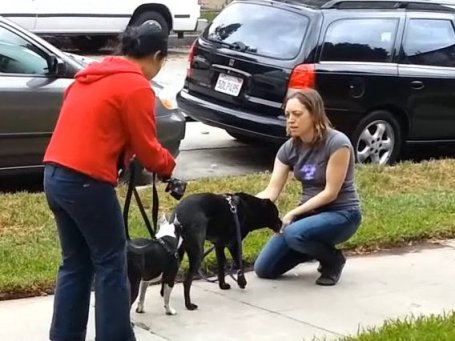
Boogie sniffs.
Above, photos of the final interaction between Boogie and Peanut. Grisha had Peanut’s butt facing Boogie for as much as possible during our walk up to the end of the session. (to quote Grisha: “The blunt end, not the pointy end”)
After about an hour of parallel walking, Boogie sniffed Peanut on the butt and I clicked. (BAT Greetings Stage 1) Boogie didn’t register the click the first time. He was so intensely sniffing. Second sniff, Boogie got even more intense and pulled forward to sniff Peanut’s crotch. After a short break from each other, I asked Boogie if he wanted to say hi again but he showed no interest in moving closer to Peanut and instead starting digging and eating dirt (sign of social anxiety, conflicted emotions).
Grisha: “He already has all the information he needed”.
We ended the walk with the two dogs standing pretty close to each other. I think they were both quite relieved that they didn’t have to do any more Parallel Walking. I live in an insanely busy neighborhood and both dogs were quite stressed. Grisha pointed out that more walks would have helped to lessen the intensity/stress of the greeting.
7. MY CHALLENGES
Sarah: “Listen to Boogie. Your job is to stay sensitive to what is actually reinforcing to him in that moment–while still helping him maintain a successful threshold distance in case he starts getting magnetized.”
Thanks to the BAT seminar and our BAT walk with Boogie and Peanut, I feel I have a ton of new information to process especially with learning how to handle the leash, remembering to relax and rebalance myself in order to help Boogie rebalance. I have learned now that BAT as a training protocol is actually a lot more fluid or organic than what I thought it was, and that in the past, I may have made things a bit aversive for Boogie by trying to stick to particular patterns that didn’t need to be stuck to, or not paying enough attention to Boogie’s thresholds & choices in relation to the general environment (not just between Boogie and an obvious trigger).
In the BAT seminar handout there was a diagram explaining the term Threshold = “the line between stress levels”. I think this has always been difficult for me. To identify where this Threshold is, exactly. I don’t want to have to let Boogie go into staring mode to gauge where his engagement zone is. (Quote Suzanne Clothier: “The Think and Learn Zone” = dog is able to split his attention between trigger and on handler) At the same time, I don’t want the opposite… I want to be sure he is engaging with the trigger, not purposely ignoring it because there are more interesting distractions around.
There is also the issue of Boogie not wanting to do BAT for long… almost as if he is bored, or it’s too much work. “Do I really have to go and look at that dog again? I already told you I am done. TWICE.”
After one or two trials, Boogie often seems ready to move on and away (“ok, I know this ol’ game”), unlike the dogs I see in Grisha’s seminar videos – who seem to happily walk back and forth, engage and disengage over and over again without other cares in the world. Would I be adding stress by having him continue BAT-ting? Or should we move on, and what exactly has been learned here? Would the fact that Boogie only wants to deal with the trigger for a very short period indicate that
1. He feels safe now ?
OR
2. Too much too soon – gotta get away from it all?
Miki sent me this Suzanne Clothier’s article on Thresholds: It’s More Than Under Or Over which I think it super helpful. ( Made me think of the Good-Cheap-Fast diagram… it’s a balancing act!)
Miki, Sarah, Grisha all brought up the same point: My environment is stressful. Boogie’s “Think and Learn Zone” is very tiny and narrow when we go on walks because there is so much stuff happening that I cannot control.
And so to summarize, I think the biggest challenges for me are still what they always have been:
- the fact that I live in a busy neighborhood with lots of people, dogs, traffic, etc. coming and going all over the place. There are so many factors outside my control. It’s as if we take 3 steps forward and 2 steps backward each day. And I don’t have a fenced private yard. Grisha suggested driving to a quieter neighborhood and practicing there.
- I can only do so much as one person. It’s hard to be vigilant about my environment (watch for triggers), practice better leash skills, and pay 100% attention to Boogie’s body language all at the same time. I need professional assistance for BAT and it would help to have video feedback. (A posse of people around with every BAT session?)
- I am not going to see significant progress until I do more BAT sessions in the right environment with nobody else around to distract Boogie or to distract me. It will be easier to read Boogie’s signals , understand his thresholds and functional rewards when we are in the right environment. Thanks to the BAT seminar, I may have connected with a few new people who have mellow decoy dogs we can practice with 🙂
Thank you again to Grisha, Peanut, Sarah, and Irith!!! – Lili & Boogie.
Disclaimer: Please note that this blog post is totally personal – these are my own observations, thoughts, and visual interpretations of the stuff I read and think about, and do not officially represent BAT. I want to mention this because I noticed that Boogie’s Blog is listed on the BAT Seminar handout 🙂
Helping dogs to be brave, Another vet visit.
I am subscribed to the posts on the Functional Rewards (BAT) Yahoo group and I really love some of the wisdom I find on here.
This question recently came up in the group:
if the dog shows a calming signal and you move the dog away, doesn’t that mean that you are afraid of the situation too cause you are moving away? a trainer told me to just go pass the person or dog to show that it does not bother you so the dog will think no big deal either.
Two responses below. First by Jude:
Moving away from a scary thing is a perfectly normal thing to do. If the dog knows that s/he can always retreat, the scary thing becomes no big deal and eventually loses its charge – exactly your goal!
However, if the dog knows s/he must go near it, then it remains a source of concern. Imagine being afraid of a poisonous snake hanging from a tree branch outside your front door and knowing that you can easily avoid it by using the side door vs. knowing that you must pass close to it each time you leave home just because your partner isn’t afraid of it and expects you to be unafraid, too.
Trying to calm an aroused animal by showing that you are not afraid does not work as a general rule and can increase an animal’s fear and/or shut down the animal. We have seen this on TV!
And by Susan Mitchell of C.A.R.E. for Animals :
I can understand what the trainer you spoke with is saying. I agree that dogs take their cues from us and that they often interpret something based on our responses (verbal and behavioral). (Sort of like kids do!) But if BAT is done correctly, it is done with the handler demonstrating calm, and even confident/happy behavior…. and in response to the DOG’S behavior. This conveys to the dog that 1- we can handle this, no need to freak out, and 2- I’m not going to be forced to ‘suck up’ my fear and face that thing over there. It really becomes a “game” or sorts for the dog that they come to understand and maybe even enjoy.
 Furthermore, I love what Susan has written below in response to another group post:
Furthermore, I love what Susan has written below in response to another group post:
I really do believe in my heart of hearts that our dogs do their absolute BEST to do what we ask of them. Sometimes it is just REALLY hard for them and they just can’t always do it. It is our job to understand what they are communicating to us and help them out. Just like they let us know when they need help…. they will also let us know when they don’t need it. And while I know others don’t agree, I personally believe that the more we offer help, the more the dogs learn to trust us, the braver they become, and the less they actually need the help.
I think this is really wonderful and inspiring, in that our ultimate goal is to help our dogs feel brave, independent, make good choices (vs. simply doing as they are told or behaving on cue). Susan adds that in teaching self-control and relaxation to our dogs, it is OK to go slow, be methodical, ask for advice along the way.
On the right is a photo taken today at the vet. This may not seem like a big deal to anybody with a normal dog, but I want to point out something quite amazing. Boogie is LYING DOWN in a room where there are dogs that he doesn’t know. There are three dogs and two cats in the room at the time this photo was taken (Later there were 6 dogs). The pup at the back is off-leash and very well-behaved. When Boogie is in a room with other dogs that he doesn’t know, he is never THIS relaxed. He will sit but never lie down like this.
This week, on two previous occasions I took Boogie out to busy public places and rewarded him with treats for lying down calmly by my side. I have also moved Boogie’s bed closer to my desk so I can reinforce calmness and quiet while he is lying down. Before, the bed was too close to the window and he got distracted very easily… couldn’t relax for long.

“Please, can we go home now?”
In other news, Boogie is suffering again from skin issues. Dr. R said that there is no staph infection this time. The allergic reactions have not (yet) progressed to a staph infection even though Boogie’s itchy skin, hot spots, hair loss, ear infection and goopy eyes don’t look so good. I told Dr. R that Boogie has also been acting sluggish and slower than normal.
Dr R: “Allergies are exhausting.”
And so I am applying Traimcinolone Cream to Boogie’s raw itchy (sometimes bloody) skin, and giving him Temaril-P – which is a steroid med – for 10 days. I really hate the side effects of steroid medications and I’m not happy about this.
I am currently researching supplements to help boost Boogie’s immune system. I am very interested in Canine Immune System Support & Doggy GOO. Any doggies out there familiar with these supplements? I’d love to get your thoughts.
When I was in the vet waiting room, a Yorkie owner advised me to give Boogie Cold-pressed Coconut Oil orally & topically – this will take care of hot spots and infections because coconut oil is anti-bacterial. Elsewhere I have read that Apple Cider Vinegar mixed with water can be used as a flea-repellent spray because of the acidity. Can anyone confirm this info? Anyone tried these natural remedies with success?
The BAT Book is here!

The book looks awesome. It is big and glossy and beautiful. Once again a big thank you to Grisha for letting me contribute to this enlightening and groundbreaking book. I’ll admit that working on this book was not like any of my other dog illustration jobs. Most of these drawings were based on and originally inspired by my own PERSONAL training experiences with Boogie so it is an extra exhilirating feeling to hold this book in my hands.
Example pages:
*click on images to see them larger
A Reactivity Chart showing “thresholds”:
Good Choices or Replacement Behaviors (instead of barking, lunging, biting etc.)
BAT On Walks, Stage 1 –
*One thing that I want to draw attention to…
Over a year ago, when I created my very first “BAT Set-Up” illustration I was still very much a BAT newbie, learning the protocol for the first time, and also learning to read Boogie. In this illustration (see below), in Step 1, even though I labeled it “Safe Distance”, the drawing of Boogie shows stress. He is clearly “over-threshold” ie, NOT at a safe distance from the trigger. In other words, my depiction of the set-up was wrong.

Note: INCORRECT illustration!
I wish I could’ve fixed this illustration before it got translated into different languages and shared around the internet, but… sigh… Thank goodness for the book! I hope that people who are still sharing the old illustration will refer to the updated version.
In the book (and also in Grisha’s latest BAT Set-Up handout) the NEW and UPDATED “BAT Set-Up” illustration shows an unstressed under-threshold dog… as he should be. The learning of Replacement Behaviors (or Good Choices) happens only when the dog is under-threshold.
A clipping from the book below, which is such an important memo.
Reactive dogs need to feel this sense of control in being able to disengage from stress on their own… which is what leads to social confidence and politeness. Hey, I think this applies to humans too. 🙂
In the last chapter of the book there are testimonials from dog trainers who have used BAT. They share their experiences . I love this one in particular from Shelly Volsche …

BAT website: www.functionalrewards.com
Order the book or ebook: HERE

In search of a private fenced yard…

Here is a photo of Boogie and Franklin from Monday’s session with trainer Irith Bloom, taken in a peaceful Huntington Palisades neighborhood.
Franklin is a very sweet and calm English Shepherd so he was the perfect “big dog” for Boogie to hang out and do parallel walking with. The funny thing is that as soon as Boogie and Franklin saw each other from a fair distance, both dogs started whining. Boogie whimpered and looked at me and pulled towards Franklin. The dogs recognized each other from their BAT session five months ago! 🙂
Boogie walks beautifully on loose-leash in my neighborhood, but because this was a new and exciting location, he was pulling like crazy. The technique of “standing still like a tree” didn’t work because Boogie kept leaning and pulling forwards regardless. Irith gave me some tips on how to deal with this problem, eg – keep my leash hand at my bellybutton, do a 180 and boldy walk forward as if there is no dog behind me until Boogie catches up on loose-leash. I did this a few times on our walk and after a while Boogie became more mindful of my existence and kept the leash loose-ish between us.
Memo to self: In a new environment, go back to training the basics.
So… as I was saying to Irith, I find these “friendly doggie sessions” so good for Boogie. I notice that whenever we have a friendly and polite experience with another dog, the following day Boogie does not react to any dogs that he sees on the street. He looks at them, turns away and moves along like it’s no big deal. He is the same after every play date with Rosie. He is more relaxed around dogs in general…
It’s a shame that Huntington Palisades is so far away from me. And Rosie also lives really far away.
I would like to do more BAT set ups with unfamiliar dogs as decoys but we need to borrow a private fenced yard — with no other dogs present –preferably in the La Brea/Fairfax area of West Hollywood. The parks are too risky with loose dogs running around.
Fenced yard, anyone?
Back home with Boogie!
It’s good to be back home with Boogie, whom I missed terribly when I was away for 2 weeks in Malaysia. I met other dogs in Malaysia and thought of Boogie. I watched
How To Train Your Dragon on the plane and thought of Boogie. Speaking of which, there is a new DVD training series from Grisha Stewart – Organic Socialization – which I cannot wait to watch. I have read that this latest DVD is even better than the first one, and what’s more, some of my dog training related illustrations are on it! 🙂
Meanwhile, here are some cool dog behavior related links:
Raising a Rubber Band Dog (Boogie is somewhere between a HDD and a SPD…)
Organic Training by Kathy Sdao
Never Punish a Dog For Growling
Dog Whispering Can Backfire (I have been drafting a very long blog post on how I feel about The Dog Whisperer. I wonder if it’s worth publishing seeing that there are already tons of passionate online articles on this topic…)
Sarah’s latest Newsletter – Who doesn’t already know about Cesar Millan’s “Exercise, Discipline and Affection” spiel? I love Sarah’s own Holy Trinity of Dog Training: “Maintenance, Exercise and Mental Stimulation”…
Sharing here a cute Boston Terrier magnet by TAPAS KIDS that I picked up at Hong Kong airport:

More later!
Training update; Walking Boogie
I am still updating Boogie’s Walk Log – where I share some excellent examples of the progress that we have made since we started training a few months ago.
I know Boogie isn’t a perfect dog, nor is he 100% “cured” of his reactivity and aggression, but the changes have been profound.
We are passing all kinds of triggers on the street, sometimes even cats and reactive dogs and I am seeing a different Boogie who doesn’t stiffen and stare like he used to. Of course he still alerts to stuff that freaks him out or makes him suspicious but in general he is a much happier and more relaxed dog. Even when he occasionally goes over threshold (when the trigger is too close), he snaps out of that state of mind really quickly, and turns back towards me. The bottom line is that all this training has made ME feel more relaxed and confident. I know what to do; he knows what to do. And when Boogie offers calming signals and doesn’t react to a trigger, this still feels like a miracle to me – it’s SO COOL.
Here are some dog-walking tips that help keep us both stress-free. I live in a busy neighborhood with people and dogs everywhere and I’ve been doing this stuff for months so I now have a system…
The B.A.T. protocol, “Look At That” Game, etc. – You can check out/download all my dog training-related illustrations HERE.
The Premack Principle (Boogie’s leash-pulling)
The Premack Principle: It states that for any two behaviors, the one that’s more likely (or that your dog prefers) can reinforce, or strengthen, the one that’s less likely (and that you might prefer). Instead of trying to get our dogs to ignore whatever excites and distracts them, we can use those excitements and distractions as rewards.
I have read about The Premack Principle and watched several YouTube videos but on Tuesday for the first time I had some hands-on experience with Sarah showing me how to use it when Boogie becomes fixated on something and pulls on the leash.The high distraction environment that we were in – Cheviot Park – was perfect for this exercise because Boogie was pulling me all over the place. The smell of squirrel was everywhere.
And so it goes that the more often that I let Boogie ignore me, the more that I am enabling his “bad behavior” and he’ll just continue to blow me off whenever he feels like it. Scolding or dragging Boogie away on the leash does not solve the problem.
So here’s the new protocol:
- When Boogie pulls, note where he wants to go.
- STOP. Stand still. Do not let myself be pulled forwards.
- WAIT. As soon as he turns around and checks in with me, I mark with a YES! (I then say “OK!” as the release cue)
- …And I let him go where he wants to go.
My questions:
Q: What if Boogie doesn’t turn around to check with me? What if he remains frozen or locked in that pulling forward position and won’t respond at all?
A: Initially we wait to mark the smallest behaviors, like an ear flick, or even if he turns his body slightly. We don’t expect a full head turn or eye contact straight away. This “splitting of behaviors into small steps” is a key feature of the Clicker Training process.
Q: What if, 5 minutes later, Boogie still remains locked and offers no signals?
A: Tap him lightly on the butt to get his attention and to break the spell. (YES, butt-tapping works!)
Q: What if I really really don’t want to go where he wants to go?
A: Let him go forwards first, then redirect him back where you want to go. Or… when he disengages from his point of fixation, just turn and walk calmly in the opposite direction with consistent leash pressure, no pulling/jerking/tugging. Hold the leash in front of the body at bellybutton level and walk. (Dogs are sensitive to different kinds of leash pressure)
——————————————————————————————————————–
BAT with FRANKLIN
On Tuesday, we also did more BAT, this time with Irith’s very friendly sweet English Shepherd, Franklin, as decoy. We got to the point where the Boogs curiously moved forward to sniff Franklin’s butt then bounced back in a play bow. (“This dog is OK! I want to play with him!”)

A more impressive moment was when Franklin moved quickly towards Boogie with direct eye contact, and Boogie instantly offered a lip lick (calming signal) and turned away. YAY!
A big thank you to Irith and Franklin for being there on Tuesday! I hope that we can organize a Boogie & Franklin playdate some day… Who wants to lend us a fenced yard?
Videos and links:
Ahimsa Dog Training: Premack Principle (youtube)
Sarah’s The Power of Premack: Fence Fighting (vimeo)
Dog Star Daily: On Shoddy Clicker Training & The Importance of Premack
Irith’s The Sophisticated Dog facebook page has some great articles on dog training.
Training Homework RECAP, Boogie’s new toy

Photo taken from this morning’s BAT session with Sarah and Irith.
We were recreating the scenario last May when Boogie attacked a person who walked through this porch speaking loudly into a cellphone.
Boogie did really well! He knew the drill, looked, then turned away from Irith and followed me into the apartment. I mixed up the rewards of treats, tennis ball, back scratches and praises.
As Irith Bloom (The Sophisticated Dog) explained to me: Even though what we do is highly repetitive (like military drills) and may seem pointless, we are teaching Boogie new habits and we want him to repeat these behaviors over and over again (in a calm under-threshold state of mind) so that they sink in and become second-nature. Should Boogie feel threatened by a strange person, we want him to instantly turn away/retreat, and look at me for direction instead of taking control and charging forwards.
I still need to work on Recall cues because Boogie tends to get distracted easily and ignore me in the case of smelly grass or squirrels.
- “Boogie!” recall, with outdoor distractions.
- “Let’s Go!” U-turn cue. Practice this many time outdoors on walks.
- “_______!” <– I need to think of a unique word or phrase to train (with extremely high value treats) and use as an Emergency Recall cue.
I know this blog is becoming very repetitive. We have these BAT sessions week after week and I write the same ol’ stuff over and over again. My apologies to Boogie blog readers. I repeat these training notes to remind myself of the progress that we are making and also to help me not get slack.
Meanwhile, here is Boogie video with one of his new toys from ROSS. Boogie takes his toys very seriously.
